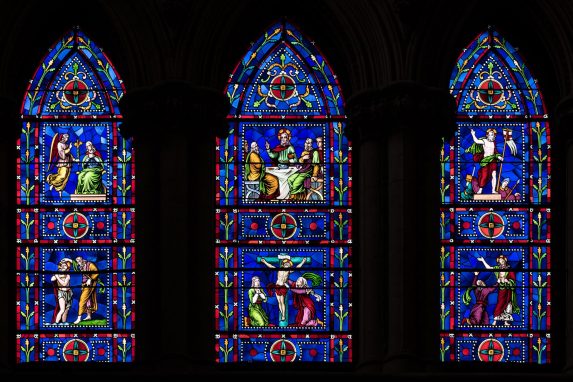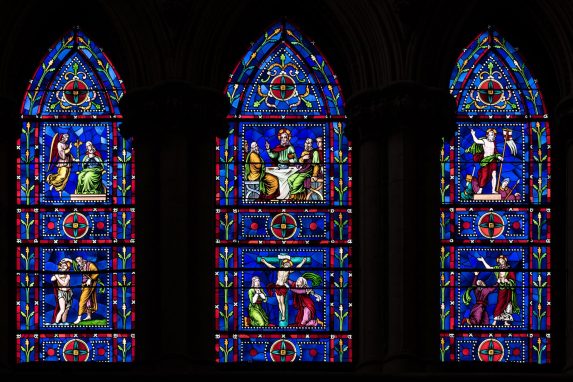Lincoln Cathedral, Lincolnshire
Address
Cathedral Church of St Mary, Minster Yard, Lincoln LN2 1PXTheme
Overview
The cathedral has retained an important collection of medieval glass, despite significant damage and re-ordering over the years. Especially significant is the ‘Dean’s Eye’ rose window in the north wall of the north transept, which still has much of its original thirteenth century glass.
The revival in stained glass in the 19th century is represented by the work of a variety of major Victorian studios, followed in the 20th century memorial windows following both World Wars.
A particular joy of Lincoln is the opportunity to compare the work of different studios in 1855 as they each interpreted the early medieval design language. Most dramatic is the east window by Ward & Hughes, in 13th century style but, under Charles Winston’s influence (as below), with bolder figure drawing and using a degree of perspective in the circular panels. By comparison in Frederick Preedy’s window in the south nave (s37 in the guide), the figures pay greater reverence to their medieval forebears in presentation, but with the fresh take that could only be made by a contemporary artist. Finally, also in the south nave, is a window by Chance Brothers (s39). It too respects the medieval context, but the central scenes are definitely Victorian.
For more information see the excellent guide book – Stained Glass of Lincoln Cathedral by Carol Bennet, Nigel J Morgan, Jim Cheshire, H Tom Küpper and Gordon Plumb, 2012
Highlight
Eight windows of the south wall of the south transeptArtist, maker and date
George Caleb Hedgeland, 1857Reason for highlighting
Conventional ideas of the style of the Victorian Gothic Revival are challenged by the eight sumptuous windows in the south-east transept created by George Hedgeland in 1857. Under the influence of Charles Winston (most well-known for his work to revive production of high quality ‘antique’ glass), and in contrast to the great east window, the imagery gives greater emphasis to earlier Classical sources.
Artist/maker notes
George Caleb Hedgeland (1825-98) was the son of John Pike Hedgeland, the architect and later stained glass artist, who work on the restoration of the medieval windows at St Neot, Cornwall. Hedgeland was admitted to the Royal Academy as an artist in 1845 and probably learnt the art of stained glass from his father. He achieved considerable success in the 1850s, exhibiting at the Great Exhibition of 1851 and rising to prominence as the designer of the Great West window at Norwich Cathedral (1853).
Unfortunately ill-health curtailed his career in England and he emigrated to Australia in 1859. There is no evidence that he work again in stained glass. His short career and the change of taste in stained glass that took place in the latter part of the century, resulting in Hedgeland fading from view, but his talents and bold pictorial style deserve a wider recognition.
Source: George Hedgeland: one life – in two parts by Angela Phippen posted on glaas inc research
Note: As a result of Angela Phippen’s investigation into the life of George Hedgeland, his descendants were encouraged to place his surviving works on paper into repositories where they could be conserved and potentially used by other researchers, including the Stained Glass Museum at Ely.



Comments by
Peter Hildebrand